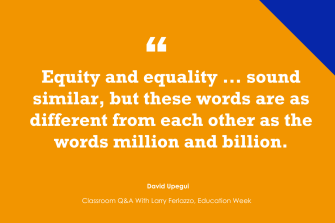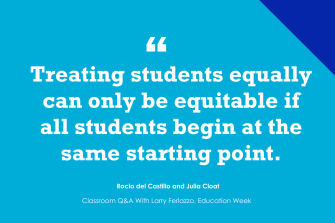Today’s post is another one in a series about the difference between equality and equity in schools.
‘Equality and Equity ... Must Co-Exist’
Ken Shelton is an award-winning educator with more than 25 years of experience. He is currently an independent consultant, adviser, designer, and keynote speaker:
Education occasionally descends into a quandary of misapplied terminology, creating misconceptions or, at times, deliberately obscuring understanding. An all too common error is conflating the concepts of “equality” and “equity"—two fundamentally different principles.
At its core, equality promotes uniform treatment: Every student receives the same textbook, the same technology. Equity, on the other hand, illuminates a more nuanced philosophy, attending to access and opportunity. It’s not just about allocating resources identically; it’s about customizing their utilization to empower every learner.
Consider a technology device given to each student—an illustration of equality. Equity builds on this by, say, offering speech-to-text options to those needing additional support while not imposing that on others who don’t require it. Equity isn’t about providing equal resources but distributing them based on individual needs to ensure equal opportunity.
I often urge educators to envision equity as a dynamic, responsive force. Its primary concern is not that everyone receives the same quantity but that each learner has precisely what they need when they need it. This approach dismantles the pervasive myth that equity operates under a zero-sum dynamic—a fear that resources granted to one learner will subtract from another.
In truth, educators will corroborate that students rarely have identical requirements simultaneously. Providing responsive, need-based support is the essence of maintaining equity. And in doing so, we ensure that no one falls below the minimum standard and, in this way, we attain equality. Thus, equality and equity, while distinct, can and must coexist to orchestrate a harmonious, inclusive learning environment. This is also why many schools and districts have undertaken the endeavor of creating an equity statement rather than an equality statement since equality is an established given.

‘We Must Do Better Than Just Promise ...”
David Upegui is a Latino immigrant who found his way out of poverty through science. He currently serves as a science teacher at his alma mater, Central Falls High School in Rhode Island and as an adjunct professor of education. He is the co-author of the upcoming book: Integrating Racial Justice Into Your High-School Biology Classroom: Using Evolution to Understand Diversity:
The words “equity” and “equality” come from the same Latin root aequus (meaning equal); and in modern English, they sound similar, but these words are as different from each other as the words “million” and “billion.” Although they come across alike, their meaning is significantly different. For example, my high school science students need to appreciate the huge differences between millions and billions of years when we discuss geological timelines. In the same way, as teachers, we must appreciate the differences between equality and equity.
Some people argue that our society needs to aim to create “equal” access to opportunity and that this goal is accomplished by providing all students with the “same” materials and content. However, this approach overlooks the huge disparate systemic structures and the unjust socio-cultural legacy that permeates our society.
Our modern world is built on the savage kidnapping, enslaving, displacement, and oppression of whole groups of peoples. As much as we would like to believe that we live in a purely egalitarian and meritocratic society, we know that current wealth and power structures are directly linked to opportunities that were afforded to those violent groups of people who benefited from the dehumanizing of others. Therefore, to provide “equal” access ignores the fact that our present lives are, at least in part, based on our collective history.
On the other hand, equity ensures fairness and impartiality in the distribution of resources, opportunities, and outcomes among all people and, in particular, those who have historically been disadvantaged or marginalized. This requires taking proactive measures to redress past injustices and creating policies and systems that promote access and opportunity for all, including providing additional resources for those who need them.
If in fact we want to create a better society where all peoples are valued for their innate characters and talents, then we must do what is needed to create opportunities that allow ALL peoples to develop their skills. Undoubtedly, this means that equity requires more energy and determined focus than equality. But the promise of elevating and liberating whole swathes of people from the shackles of unjust structures and systems surely is worth the extra effort. Our students, the future stewards of the earth, will not be able to solve the problems they will inherit if we limit the development of their skills. We must do better than just promise equality, we must deliver equity.
We can begin to reach for equity by ensuring that opportunities are offered to students from historically minoritized and underrepresented groups. We must actively recruit, nurture, and promote students from diverse backgrounds. We have to recognize that if we continue to do things that we have been doing, change is not going to happen. So if we want the benefits for a culturally rich society, we need to invest in all peoples as if they are the individuals who will ensure the survival of the human species.
When we limit some people from accessing the structures they need to fully develop, we rob them, their community, and our world of those talents. Let’s create a society and world that nurtures and benefits from our beautifully diverse human species.

‘Get to Know Your 69��ý’
Rocio del Castillo, a co-author of Teaching 69��ý in Spanish, is an administrator, a professor, and an advocate for an asset-based approach to multilingual education who lives in Illinois and has recently co-founded Via Educational Consulting.
Julia Cloat is a co-author of Teaching 69��ý in Spanish and an associate superintendent who lives in northern Illinois and has recently co-founded Via Educational Consulting:
The difference between equality and equity is a crucial distinction for educators to make. To avoid the confusion between these two belief systems, we must shift our thinking from an orientation of “fair is equal.” Focusing on equality distracts us from our responsibilities to overcome institutional bias and inequity in our society. As teachers, we will better serve our students if we recognize the essential contrast between treating your students equally and treating them equitably.
● Treating students equally means that all students receive the same treatment regardless of their needs.
● Treating students equitably means that all students receive what they need, when they need it.
Treating students equally can only be equitable if all students begin at the same starting point and can achieve success with the exact same opportunities, access, and resources. It is extremely unlikely that within one classroom, all students will be at the same starting point. Teachers and administrators must work to establish a culture of equity in which every student has access to the educational resources and rigor they need at the right moment in their education regardless of race, gender, ethnicity, language, disability, sexual orientation, family background, and/or family income.
In truth, we must keep in mind that equity is a foundation, mindset, and approach. There are, however, steps that teachers can take in order to make the learning environment and the instruction more inclusive. These ideals are woven throughout our book and are summarized here:
1. Acknowledge your biases
We frequently think as teachers that we can be objective with our students. Despite our best efforts, we all have values, beliefs, and predispositions that influence how we interact with others. These assumptions aren’t always bad, since they might help us grasp unfamiliar circumstances or make sense of what’s going on around us. However, when our preconceptions materialize as implicit biases that might lead to forced identities, we unconsciously perpetuate unfavorable stereotypes and school cultures (Hanselman, et al., 2014).
In reality, teachers’ implicit biases may frequently lead to lowered goals or expectations for children of color and kids from underserved communities. Understanding hidden associations, assumptions, or biases allows us to gain a better understanding of our “self” so we can collaborate with “others” to achieve a mediated identity in which positive academic and social identities can be affirmed and nurtured (Delpit, 1995; Nieto & Bode, 2011).
2. Get to know your students
Understanding who your students are and their interests can assist you in providing them with high-quality learning opportunities. Getting to know students and the factors that influence their personal and family lives will help teachers to make lessons more culturally sustaining and to build relationships. Considering factors such as socioeconomic status, family make-up, and the educational expectations and goals they have for the child will provide opportunities to make the learning experiences more personalized and better meet the students’ needs.
3. Differentiate your teaching and curriculum
To embrace culturally sustainable practices in your classroom, consider what you have learned about your students and make sure that your focus, standards, instructional approaches, and materials reflect their cultures and expose them to different cultures. Additionally, authentic forms of assessment tools (e.g., observations, rubrics, conferring, performance tasks) are a more culturally and linguistically sustaining way to assess student performance and progress than more traditional classroom assessments.
4. Involve family and community
Making the learning environment in your classroom more inclusive and culturally sustaining means engaging families and communities in the school lives of students. By supporting students’ bicultural- and multicultural-identity development, families will feel more included and more comfortable, ultimately, making it more likely that they become partners with their children’s school.
At the surface level, it may seem unfair to the classroom or school community as a whole that some students are provided with more resources or opportunities than others. However, when everyone gets what they need in ways that disrupt systemic and societal inequities, the benefits are felt by all. Rising water in a lake elevates all boats (to paraphrase John F. Kennedy, who may have said something similar), not just those who have spent decades bailing water just to keep afloat.

Thanks to Ken, David, Rocio, and Julia for contributing their thoughts!
Today’s post answered this question:
It’s not unusual for districts, schools, and educators to confuse “equality” with “equity.” What are examples, and ways, you would help them understand the difference?
Part One in this series featured responses from Jehan Hakim, Mary Rice-Boothe, Jennifer Cárdenas, and Shaun Nelms.
In Part Two, Karen Baptiste, PJ Caposey, and Denise Fawcett Facey contributed their perspectives.
In Part Three, Jamie Wallace, Elaine V. Howes, Courtney Rose, and Angela M. Ward wrote their answers.
Consider contributing a question to be answered in a future post. You can send one to me at lferlazzo@epe.org. When you send it in, let me know if I can use your real name if it’s selected or if you’d prefer remaining anonymous and have a pseudonym in mind.
You can also contact me on Twitter at .
Just a reminder; you can subscribe and receive updates from this blog via . And if you missed any of the highlights from the first 12 years of this blog, you can see a categorized list here.




